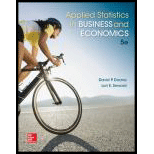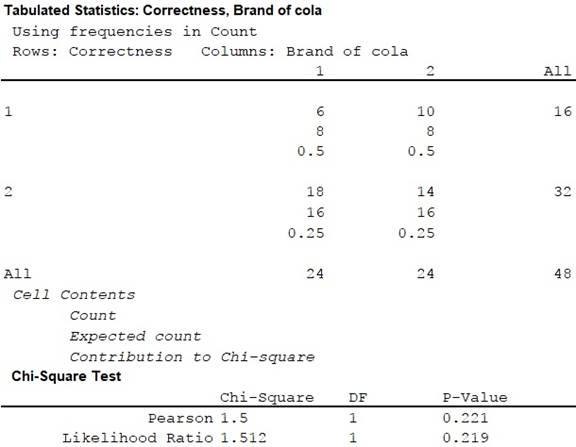
State the null and alternative hypothesis.
Find the degrees of freedom for the
Find the critical value of chi-square from Appendix E or from Excel’s
Calculate the chi-square test statistics at 0.05 level of significance.
Interpret the p-value.
Check whether the conclusion is sensitive to the level of significance chosen, identify the cells that contribute to the chi-square test statistic and check for the small expected frequencies.
Perform a two-tailed, two-sample z test for
Answer to Problem 30CE
The null hypothesis is:
And the alternative hypothesis is:
The degrees of freedom for the contingency table is 1.
The critical-value using EXCEL is 3.841.
The chi-square test statistics at 0.05 level of significance is 1.50.
The p-value for the hypothesis test is 0.221.
There is enough evidence to conclude that the correct response and type of cola are independent.
The conclusion is not sensitive to the level of significance chosen.
The cells (1, 1) and (1, 2) contribute the most to the chi-square test statistic.
There is no expected frequencies that are too small.
It is verified that
Explanation of Solution
The table summarizes the grade and order of papers handed in.
The claim is to test whether the data provide sufficient evidence to conclude that the grade and order handed in are independent. If the claim is rejected, then the grade and order handed in are not independent.
The test hypotheses are given below:
Null hypothesis:
Alternative hypothesis:
The degrees of freedom can be obtained as follows:
Substitute 2 for r and 2 for c.
Thus, the degrees of freedom for the contingency table is 1.
Procedure for critical-value using EXCEL:
Step-by-step software procedure to obtain critical-value using EXCEL software is as follows:
- Open an EXCEL file.
- In cell A1, enter the formula “=CHISQ.INV.RT(0.05,1)”
- Output using EXCEL software is given below:

Thus, the critical-value using EXCEL is 3.841.
Test statistic:
Software procedure:
Step by step procedure to obtain the chi-square test statistics and p-value using the MINITAB software:
- Choose Stat > Tables >Cross Tabulation and Chi-Square.
- Choose Row data (categorical variables).
- In Rows, choose Grade.
- In Columns, choose Order handed in.
- In Frequencies, choose Count.
- In Display, select Counts.
- In chi-square, select Chi-square test, Expected cell counts and Each cell’s contribution to chi-square.
- Click OK.
Output using the MINITAB software is given below:

Thus, the test statistic is 1.50 and the p-value for the hypothesis test is 0.221.
Rejection rule:
If the p-value is less than or equal to the significance level, then reject the null hypothesis
Conclusion:
Here, the p-value is greater than the level of significance.
That is,
Therefore, the null hypothesis is not rejected.
Thus, the data provide sufficient evidence to conclude that the correct response and type of cola are independent.
Take
Here, the p-value is greater than the level of significance.
That is,
Therefore, the null hypothesis is not rejected.
Thus, the data provide sufficient evidence to conclude that the correct response and type of cola are independent.
Thus, the conclusion is same for both the significance levels.
Hence, the conclusion is not sensitive to the level of significance chosen.
The cells (1, 1) and (1, 2) contribute the most to the chi-square test statistic.
Since all
Two-tailed, two-sample z test:
The test hypotheses are given below:
Null hypothesis:
Alternative hypothesis:
The proportion of “yes” responses to the regular cola is denoted as
Where
The proportion of number of “yes” responses to the diet cola is denoted as
Where
The pooled proportion is denoted as
Test statistic:
The z-test statistics can be obtained as follows:
Thus, the z-test statistic is –1.22.
The square of the z-test statistic is,
Thus the square of the z-test statistic is same as the chi-square statistics.
Procedure for p-value using EXCEL:
Step-by-step software procedure to obtain p-value using EXCEL software is as follows:
- Open an EXCEL file.
- In cell A1, enter the formula “=2*(1-NORM.S.DIST(–1.22,1))”
- Output using EXCEL software is given below:

Thus, the p-value using EXCEL is 1.778, which is not same as the p-value obtained in chi-square test. But the square of the z-test statistic is same as the chi-square statistics.
Thus, it is verified that
Want to see more full solutions like this?
Chapter 15 Solutions
Applied Statistics in Business and Economics with Connect Access Card with LearnSmart
- The personality trait of "Conscientiousness" (someone who is organized, responsible, and can control their impulses) has μ = 120 and σ =9. Test whether ARC students (n = 9, M = 126) differ on Conscientiousness. α = .05. Does the z score for the sample mean lie in the critical region (beyond the critical boundary)?arrow_forwardThe critical value(s) is/are t0= ? Find the standardized test statistic ? Decide whether to reject or fail to reject the null hypothesis.? Interpret the decision in the context of the original claim. ?arrow_forwardRefer to the data display from a sample of airport data speeds in Mbps. What is the number of degrees of freedom that should be used for finding the critical value ta/2 ?arrow_forward
- A third study is run to estimate the effect of the low-carbohydrate diet on cholesterol levels. In the study, participants' cholesterol levels are measured before starting the program and then again after 6 months on the program. The datar are shown below. Is there a significant increase in cholesterol after 6 months on the low-carbohydrate diet? Run the appropriate test at a 5% level of significance.arrow_forwardAverage IQ scores for young school children are known to be 100 (SD = 15). However, the literature indicates that children’s intelligence may be decreased if their mothers have German measles during pregnancy. Using hospital records, a researcher obtained a sample of n = 25 school children whose mothers all had German measles during their pregnancies. Do the data indicate that children born to mothers who had German measles during the pregnancy have significantly lower IQ scores than typical young school children? child IQ scr 1 91 2 111 3 97 4 95 5 96 6 95 7 95 8 96 9 94 10 93 11 95 12 92 13 96 14 91 15 97 16 93 17 92 18 99 19 93 20 97 21 85 22 94 23 96 24 95 25 96 a. What is the independent variable in the research study? b. Is the independent variable categorical or quantitative? c. What is the dependent variable in…arrow_forwardAverage IQ scores for young school children are known to be 100 (SD = 15). However, the literature indicates that children’s intelligence may be decreased if their mothers have German measles during pregnancy. Using hospital records, a researcher obtained a sample of n = 25 school children whose mothers all had German measles during their pregnancies. Do the data indicate that children born to mothers who had German measles during the pregnancy have significantly lower IQ scores than typical young school children? child IQ scr 1 91 2 111 3 97 4 95 5 96 6 95 7 95 8 96 9 94 10 93 11 95 12 92 13 96 14 91 15 97 16 93 17 92 18 99 19 93 20 97 21 85 22 94 23 96 24 95 25 96 A. Is the dependent variable categorical or quantitative? A B. What is the mean IQ for the sample? B C. What is the sample standard deviation? C D. What…arrow_forward
- Dr. Castillejo feels that the maximum pulse rate during the run is a good predictor in explaining the oxygen consumption in the blood stream. He asserts that if the pulse rate at the end of the run increased, then the oxygen consumption will also increase, hence his/her heart is functioning well. Based on the R commanderoutput below, check if the data on oxygen consumption and maximum pulse rate (from 152 bpm to 196bpm) support Dr. Castillejo’s assertion.arrow_forwardUse SPSS to run the analysis described in Question 6. What is the obtained t-statistic? Enter the value with three decimal places. If it is negative, be sure to include the sign.arrow_forwardUse Spearman rho to test the hypothesis at 5% level of significance in which there is no significant correlation between mental ability and English proficiency. What is the value of ΣD2? What is the absolute calculated ρ(rho) value? Using the tabulated value ρtab = 0.648, what is the decision? accept or reject Ho?arrow_forward
- Which two fields of the ANOVA summary table help us find the critical value? Select all that apply A.df between B.MS within C.df within D. MS betweenarrow_forwardThe lower quartile (Q1) height for JV players is the same as the ______ for Varsity players.arrow_forwardCalculate the F statistic for the model. Test whether R square is equal to ‘0’ at the 5% significance level if the critical F value is 2.71.arrow_forward
 Glencoe Algebra 1, Student Edition, 9780079039897...AlgebraISBN:9780079039897Author:CarterPublisher:McGraw Hill
Glencoe Algebra 1, Student Edition, 9780079039897...AlgebraISBN:9780079039897Author:CarterPublisher:McGraw Hill
